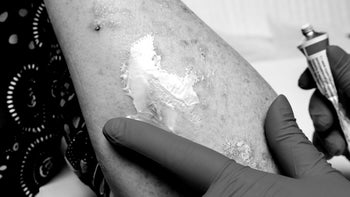
What Dermatology Services Will Your Insurance Cover?
Key takeaways:
Dermatologists and dermatology practices offer a range of in-office services to address skin conditions such as acne, eczema, and psoriasis.
In general, health insurance plans only pay for dermatological services they consider to be medically necessary, which excludes most cosmetic treatments.
If you can use your insurance for a dermatology service, make sure to go to a provider who is in network. If your service isn’t covered, ask about payment plans or discounts.

The skin is the body’s largest organ. Having good health involves taking care of your skin. In fact, it’s estimated that one in three Americans experience a skin condition at any given time. Some of the most common skin conditions include acne, eczema, and psoriasis. Many patients and healthcare providers rely on over-the-counter and prescription medications to help treat these conditions, but sometimes additional professional procedures are warranted.
Dermatology services performed in-office can be a useful solution to skin issues both medical and cosmetic. If you have insurance, some of these procedures may be covered when deemed medically necessary. Services that your insurance plan considers to be cosmetic are not typically covered.
Here’s what you need to know about insurance coverage and procedures to treat your skin.
One Prescription + One Pump + Once a Day
Introducing CABTREO: the treatment that has clindamycin phosphate, adapalene, and benzoyl peroxide all in one topical application. Now cash pay patients pay no more than $100 using GoodRx.

Common dermatological procedures (and their costs)
There are many in-office treatments for acne, wrinkles, and other skin concerns.
Dermatological procedures often covered by insurance
Steroid injections: For deep, painful acne nodules or cysts, a cortisone injection can flatten the lump and clear redness within days. These shots also can be used to flatten keloids and other scars. While it’s not uncommon for insurance to cover this treatment, you may still have to pay out of pocket if you haven’t met your deductible. After that, you may have a copay or coinsurance. Without insurance, these injections can exceed $100 per shot.
Surgery: In some cases, your doctor may want to perform a surgical procedure to drain a stubborn blemish. Surgery also can be an option to remove skin tags, moles, keloids, and other scars. Health plans often consider this type of surgery to be medically necessary, so it’s typically covered by insurance. Your out-of-pocket costs may include meeting a deductible and copays or coinsurance. In some cases, however, surgery is not covered. Mole removal surgery, for instance, is usually considered cosmetic if the mole isn’t medically worrisome. Depending on the method used, you should expect mole removal to cost anywhere from $150 to more than $1,500 without insurance.
Light therapy: Exposing skin to different types of UV light — a technique known as light therapy or phototherapy — can treat psoriasis, eczema, and vitiligo. Most people need multiple, consistent treatments for it to be effective. A phototherapy session can cost about $65 without insurance, but you may need 20 to 36 sessions over the course of several weeks, which can push the cost into the thousands. Home UV light therapy can be an effective and more affordable option. Home phototherapy units can cost from a few hundred dollars for a handheld unit to several thousand dollars for a full-body lamp panel. Your insurance may cover in-office light therapy sessions or certain home phototherapy units.
Dermatological procedures usually not covered by insurance
Chemical peels: Chemical peels can help control certain types of acne and improve the appearance of acne scarring and wrinkles. These peels are considered experimental or investigational by most health plans, which means they won’t be covered by insurance. Depending on the treatment, a chemical peel can cost anywhere from $100 to $6,000. In general, the deeper the peel, the higher the cost. According to the American Society of Plastic Surgeons, the average cost of a chemical peel is more than $500.
Facials: A facial is typically performed by a licensed esthetician. This may happen in a dermatologist’s office or a spa. A facial generally includes cleansing, steam treatment, masks, and extractions of blocked pores. Prices range from less than $100 to several hundred dollars, depending on the treatments you get.
Laser therapy: Laser skin resurfacing can help treat scars and discoloration caused by acne. At a dermatologist’s office, you can expect to pay $400 to $2,500 per session.
Microdermabrasion: Microdermabrasion can improve uneven skin tone, brighten dark spots, and improve a dull complexion. According to the American Society of Plastic Surgeons, the average cost of microdermabrasion is $167. You may need several sessions to get the best results.
Out-of-pocket costs to expect if your insurance covers dermatology services
As mentioned, health insurance typically covers dermatology services deemed medically necessary. Commercial insurance, Medicare, Medicaid, and Tricare all cover certain dermatology services.
If your commercial health insurance or Medicare plan considers a procedure medically necessary, you’ll need to meet your deductible before your insurance begins cost-sharing. After that, you may be responsible for a copay or coinsurance for each visit. Your charges may vary depending on whether you see a primary care physician or a specialist such as a dermatologist or plastic surgeon. Out-of-pocket costs are usually nominal for Medicaid and Tricare.
If you have a flexible spending account (FSA) or a health savings account (HSA), you can usually use funds from those accounts to pay for dermatological services such as acne treatments. You can also use these accounts for prescription and over-the-counter skin care.
Read more like this
Explore these related articles, suggested for readers like you.
How to identify dermatology services covered by your insurance
To find out what is and isn’t covered by your insurance, look through your plan’s summary of benefits and coverage (SBC). All health plans are required to have an SBC, which lists the services the plan covers, what’s not covered, and the difference between in-network and out-of-network coverage. You can find your SBC through your online patient portal or by contacting your insurance company.
If your health plan has an online tool to search for healthcare providers, you can use it to make sure the provider you want to see is in your insurance network.
You should talk to your provider or contact your insurance company if you have questions.
What to do if a procedure isn’t covered
If a dermatology service recommended by your healthcare provider isn’t covered by your insurance, you might consider discussing alternative treatments. If you’ve tried or ruled out other options, ask your doctor’s office about discounts that may be available to you. For example, some practices offer a discount if you pay for the entire procedure up front. If you don’t have the cash on hand, you can consider medical financing options, such as a medical credit card, which may offer you affordable payments over time. You could also make a payment plan arrangement with your provider.
The bottom line
Dermatology services that are typically covered by insurance include steroid injections, surgery, and light therapy — if they are deemed medically necessary. Chemical peels, facials, laser therapy, and microdermabrasion are far less likely to be covered by your health insurance. Review your summary of benefits and coverage to find out what dermatology services are covered by your plan. If a procedure isn’t covered, and you’ll have to pay cash, set up a payment plan with your provider, or explore other financing options, such as a medical credit card.
Why trust our experts?



References
American Academy of Dermatology Association. (n.d.). Microdermabrasion: Overview.
American Society of Plastic Surgeons. (n.d.). How much does a chemical peel cost?
American Society of Plastic Surgeons. (n.d.). How much does microdermabrasion cost?
Bayless, K. (2022). Chemical peel costs, types and benefits for your skin. CareCredit.
National Center for Complementary and Integrative Health. (2019). Skin conditions at a glance.
National Psoriasis Foundation. (2022). Phototherapy.
Paretts, S. (2022). Psoriasis vs. eczema: What’s the difference? CareCredit.
Torres, A. E., et al. (2021). Role of phototherapy in the era of biologics. Journal of the American Academy of Dermatology.
UV Derma. (2023). Products.





























